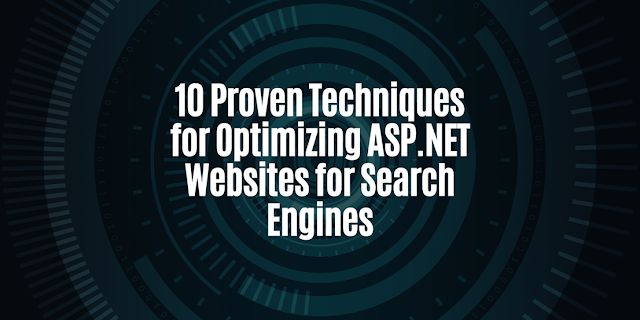ASP.NET is a popular web development platform that allows developers to create dynamic and scalable web applications. While it has many benefits, optimizing an ASP.NET website for search engines can be a challenge. The good news is that there are a number of best practices that you can follow to improve your website's SEO and visibility.
Here are 10 of the best practices for optimizing ASP.NET websites for search engines:
Use clean and descriptive URLs
One of the most important things you can do for your website's SEO is to make sure your URLs are clean and descriptive. Ideally, each page of your website should have a unique URL that accurately reflects the page's content. For example, instead of using a URL like "www.yoursite.com/page.aspx?id=1234", you should use "www.yoursite.com/page-title".
Implement schema markup
Schema markup is a type of structured data that you can add to your website to help search engines better understand the content on your pages. For example, you can use schema markup to specify information such as the date a post was published, the author of the post, and the main image associated with the post.
Optimize your content
One of the keys to good SEO is to have high-quality content that is optimized for both users and search engines. To optimize your content, you should focus on creating well-written, original content that provides value to your audience. You should also make sure your content is keyword-optimized and uses appropriate headings, subheadings, and bullet points.
Use descriptive and optimized page titles
The title of each page of your website is one of the most important elements for SEO. Page titles should be descriptive and include the keywords that you want to target. They should also be unique and less than 60 characters in length.
Optimize your images
Images can play an important role in your website's SEO. To optimize your images, you should use descriptive file names and alt tags, compress images to reduce file sizes, and make sure images are properly sized for the web.
Use internal linking
Internal linking refers to the practice of linking from one page of your website to another. This can help search engines understand the structure of your website and also help users navigate your site more easily.
Use social media to promote your content
Social media can play a big role in your website's SEO. By promoting your content on social media, you can drive more traffic to your website and help search engines understand the popularity and relevance of your content.
Monitor your website's performance
To optimize your website for search engines, you need to monitor its performance over time. You can use tools such as Google Analytics to monitor your website's traffic, see which pages are performing well, and identify areas for improvement.
Use a sitemap
A sitemap is a file that lists all of the pages on your website and is used by search engines to crawl and index your site. By creating and submitting a sitemap to search engines, you can help ensure that all of the pages on your website are properly indexed.
Continuously improve and update your website
Finally, the best way to optimize your ASP.NET website for search engines is to continually improve and update it. This means adding new content, making updates to your site's design and structure, and fixing any technical issues that arise.
Final Words
Optimizing an ASP.NET website for search engines requires a combination of technical skills and a focus on creating high-quality, relevant content. By following the best practices outlined in this article, you can help ensure that your website is visible to search engines and appears high in search results. This, in turn, can drive more traffic to your website and help you reach your target audience. However, optimizing your website is an ongoing process, and you should continuously monitor its performance and make updates as needed to stay ahead of the competition.

